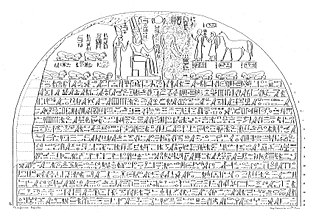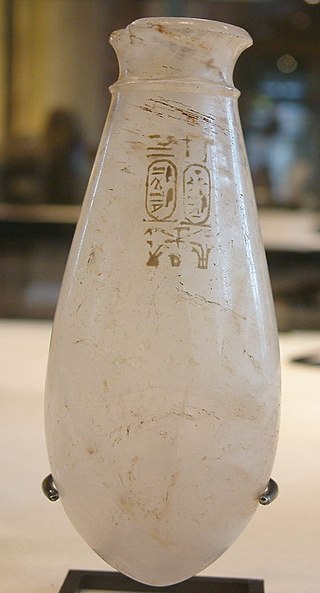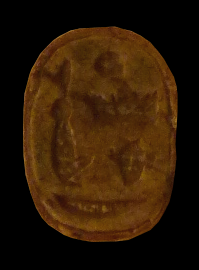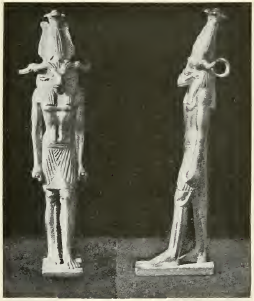
Piye was an ancient Kushite king and founder of the Twenty-fifth Dynasty of Egypt, who ruled Egypt from 744–714 BC. He ruled from the city of Napata, located deep in Nubia, modern-day Sudan.

The Third Intermediate Period of ancient Egypt began with the death of Pharaoh Ramesses XI in 1077 BC, which ended the New Kingdom, and was eventually followed by the Late Period. Various points are offered as the beginning for the latter era, though it is most often regarded as dating from the foundation of the Twenty-Sixth Dynasty by Psamtik I in 664 BC, following the departure of the Nubian Kushite rulers of the Twenty-fifth Dynasty after they were driven out by the Assyrians under King Ashurbanipal. The use of the term "Third Intermediate Period", based on the analogy of the well-known First and Second Intermediate Periods, was popular by 1978, when British Egyptologist Kenneth Kitchen used the term for the title of his book on the period. While Kitchen argued that the period was 'far from being chaotic' and hoped that his work would lead to the abolishment of the term, with his own preference being the 'Post-Imperial epoch', his use of the term as a title seems only to have entrenched the use of the term.

Hedjkheperre Setepenre Takelot II Si-Ese was a pharaoh of the Twenty-third Dynasty of Ancient Egypt in Middle and Upper Egypt. He has been identified as the High Priest of Amun Takelot F, son of the High Priest of Amun Nimlot C at Thebes, and thus, the son of Nimlot C and grandson of king Osorkon II, according to the latest academic research. Based on two lunar dates belonging to Takelot II, this Upper Egyptian pharaoh is today believed to have ascended to the throne of a divided Egypt in either 845 BC or 834 BC. Most Egyptologists today, including Aidan Dodson, Gerard Broekman, Jürgen von Beckerath, M.A. Leahy, and Karl Jansen-Winkeln, also accept David Aston's 1989 hypothesis that Shoshenq III was Osorkon II's actual successor at Tanis, rather than Takelot II. As Aidan Dodson and Dyan Hilton write in their comprehensive book on the royal families of Ancient Egypt:
Takelot II is likely to have been identical with the High Priest Takelot F, who is stated in [the] Karnak inscriptions to have been a son of Nimlot C, and whose likely period of office falls neatly just before Takelot II's appearance.

Usermaatre Setepenamun Osorkon II was the fifth king of the Twenty-second Dynasty of Ancient Egypt and the son of King Takelot I and Queen Kapes. He ruled Egypt from approximately 872 BC to 837 BC from Tanis, the capital of that dynasty.

Sekhemkheperre Osorkon I was an ancient Egyptian pharaoh of the 22nd Dynasty. Osorkon's territory included much of the Levant.

The Twenty-third Dynasty of Egypt is usually classified as the third dynasty of the ancient Egyptian Third Intermediate Period. This dynasty consisted of a number of Meshwesh kings, who ruled either as pharaohs or as independent kings of parts of Upper Egypt from 880 BC to 720 BC, and pharaohs from 837 BC to 728 BC.
The Meshwesh was an ancient Libyan tribe, of Berber origin along with other groups like Libu and Tehenu/Tjemehu.also of the Sea Peoples

Shepsesre Tefnakht was a prince of Sais and founder of the relatively short Twenty-fourth Dynasty of Egypt; he rose to become a Chief of the Ma in his home city. He is thought to have reigned roughly 732 BCE to 725 BCE, or seven years. Tefnakht I first began his career as the "Great Chief of the West" and Prince of Sais and was a late contemporary of the last ruler of the 22nd Dynasty: Shoshenq V. Tefnakht I was actually the second ruler of Sais; he was preceded by Osorkon C, who is attested by several documents mentioning him as this city's Chief of the Ma and Army Leader, according to Kenneth Kitchen, while his predecessor as Great Chief of the West was a man named Ankhhor. A recently discovered statue, dedicated by Tefnakht I to Amun-Re, reveals important details about his personal origins. The statue's text states that Tefnakht was the son of a certain Gemnefsutkapu and the grandson of Basa, a priest of Amun near Sais. Consequently, Tefnakht was not actually descended from either lines of Chiefs of the Ma and of the Libu as traditionally believed but rather came from a family of priests, and his ancestors being more likely Egyptians rather than Libyans.

Tefnakht II was an ancient Egyptian ruler of the city of Sais during the early 7th century BC. He is recognized as an early member of the so-called "Proto-Saite Dynasty", which directly preceded the 26th Dynasty of Egypt.

Usermaatre Setepenamun Takelot III Si-Ese was Osorkon III's eldest son and successor. Takelot III ruled the first five years of his reign in a coregency with his father, according to the evidence from Nile Quay Text No.13, and succeeded his father as king the following year. He served previously as the High Priest of Amun at Thebes. He was previously thought to have ruled Egypt for only 7 years until his 13th Year was found on a stela from Ahmeida in the Dakhla Oasis in 2005.

Rudamun was the final pharaoh of the Twenty-third Dynasty of Egypt. His titulary simply reads as Usermaatre Setepenamun, Rudamun Meryamun, and excludes the Si-Ese or Netjer-Heqawaset epithets employed by his father and brother.

Usermaatre Osorkon IV was an ancient Egyptian pharaoh during the late Third Intermediate Period. Traditionally considered the last king of the 22nd Dynasty, he was de facto little more than ruler in Tanis and Bubastis, in Lower Egypt. He is generally – though not universally – identified with the King Shilkanni mentioned by Assyrian sources, and with the biblical So, King of Egypt mentioned in the second Books of Kings (17:4).

Nimlot C was a High Priest of Amun at Thebes during the reign of pharaoh Osorkon II of the 22nd Dynasty.
Shoshenq A, sometimes also called Shoshenq the Elder, was a Great Chief of the Ma during the 21st Dynasty of ancient Egypt. He is mainly known for being an ancestor of the 22nd Dynasty pharaohs.

Iuput II was a ruler of Leontopolis, in the Nile Delta region of Lower Egypt, who reigned during the 8th century BC, in the late Third Intermediate Period.

The Twenty-fourth Dynasty of Egypt is usually classified as the fourth Dynasty of the Ancient Egyptian Third Intermediate Period.

Nimlot was an ancient Egyptian ruler ("king") of Hermopolis during the 25th Dynasty.

Peftjauawybast or Peftjaubast was an ancient Egyptian ruler ("king") of Herakleopolis Magna during the 25th Dynasty.

Nimlot A was a Great Chief of the Ma during the late 21st Dynasty of ancient Egypt. He is mainly known for being the father of the founder of the 22nd Dynasty, pharaoh Shoshenq I.

Nimlot B, also Nemareth was an ancient Egyptian prince, general and governor during the early 22nd Dynasty.
















